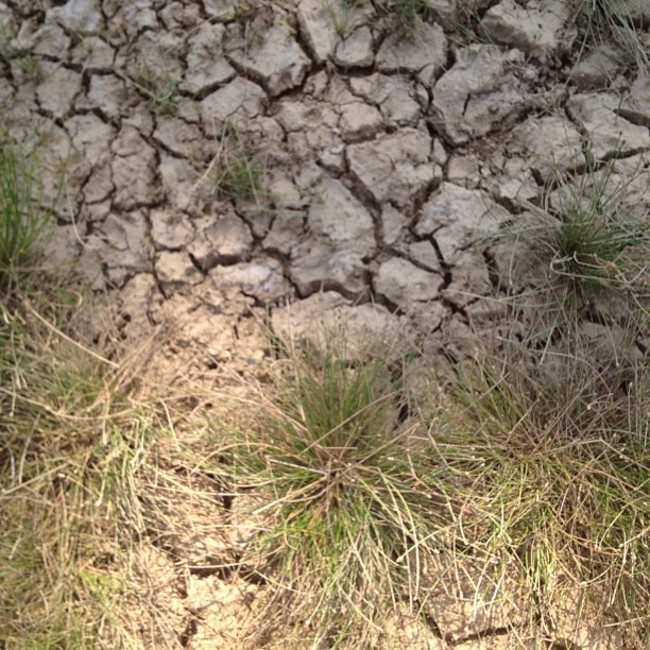 The drought takes its toll. The bottom of a "pond" dries up.
The drought takes its toll. The bottom of a "pond" dries up.
Right now our area is anywhere from 30-50% behind average annual rainfall. The ground “crunches” when you walk on it. There’s still plenty of green rose bushes, lespedeza and other plants that can tolerate the drought, but all the fescue, johnson and orchard grass is dead. At least we have some grass though. Not many people in our area do. Literally every person we know that raises animals in our neck of the woods is feeding hay right now.
Feeding hay isn’t typical in June and the beginning of July. There’s generally enough pasture to go around. Our neighbors say they’ll sometimes need to feed hay at the end of August or early September if the fall rains start late (or never come), but very rarely do they start feeding hay this early in the summer.
When we drive to town it’s pasture after pasture of bare dirt. Cows and horses eating hay off tens, or even hundreds, of acres of dirt. A few months ago those fields were lush. And there’s a high likelihood that those fields would still have some grass if the farmers started rotationally grazing.
One thing is very consistent with all the farms we drive past. There’s no grazing management taking place.
Rotationally Grazing. Grazing Management
Managed rotational grazing is when you control where and which pasture the animals are eating at any given time. The goal is to graze an area and then not graze it again until the plants have recovered. If you’re going through a drought it could take 3-4 months for a piece of land to grow back. The soil and the plants need TIME to recover. You can’t just let the animals keep eating back all the new growth the instant it pops out of the ground.
To truly rotationally graze you need to be able to let the land you’re grazing rest until the grass has grown back again. Some people say 6 inches or higher, others just eyeball and know when they can bring the animals back. Let the animals eat down one area, leave it alone for a while, and then come back to it when it’s ready to be grazed again.
 REST creates REGROWTH. Give the pasture a break from grazing, let the grass regrow
REST creates REGROWTH. Give the pasture a break from grazing, let the grass regrow
If you’re not rotationally grazing it’s a lot like mowing your lawn everyday and dropping the blade height each day. When the grass is growing and the rain is falling you might not be able to keep up with the grass growth. But when it hasn’t rained in over a month and the temps are 110 degrees for six days straight you’ll quickly be mowing a dirt field. And that’s what happens with all the fields we see along the road. Their “lawn mowers” (aka cows and horses) are out there mowing all day, everyday. Instead of having the cows mow one small field each day the cows are left to roam the entire acreage, effectively mowing it all down and killing the grass. Ironically, all of the front lawns look fantastic. I bet they haven’t been mowed in weeks...
No Grass No Soil
When you kill the grass you kill the soil. That’s why we have deserts in the West. The soil is dead and it’s because the grass is dead. The grass is dead because there’s no more herds of grazing animals. It’s not that the animals ate all the grass, it’s that the animals were removed through over-hunting and the grass NEEDS the animals to stay alive. It's an ecosystem of interdependency.
The ecosystem involved millions of American buffalo in huge herds that roamed the plains. They moved in big herds, eating the grass, stomping the ground, depositing manure and urine and never staying in one place for too long. The buffalo moved seasonally and never stayed in one spot for too long due to predator pressure. The deserts require animal impact to break up the hard ground, move seeds (in the cows stomachs), deposit manure, etc. There are detailed accounts of lush pastures in the American West that we now think of as a desert.
We are attempting to recreate that ecosystem at Little Seed Farm. We move our goats and cows in small areas all around our pastures. They won’t graze the same areas that they’re grazing right now until the fall at the earliest and maybe not until next spring if the land has a particularly hard time recovering from this drought. If you bring them back too soon it just kills the plants and defeats the purpose.
There are many other benefits to rotational grazing as well. I find it incredibly fascinating and will certainly write more in the future. I hope you find it as interesting as I do.
Rotational grazing is the most important management aspect of our farm. We spend a lot of time thinking about it and implementing it. It’s labor intensive and requires a lot of patience and observation. We’re novices, but we learn a lot from reading old texts and speaking with farmers who use similar practices. One day we hope the rotational grazing will restore our pastures to better health and help us manage through similar droughts when we have more animals.
